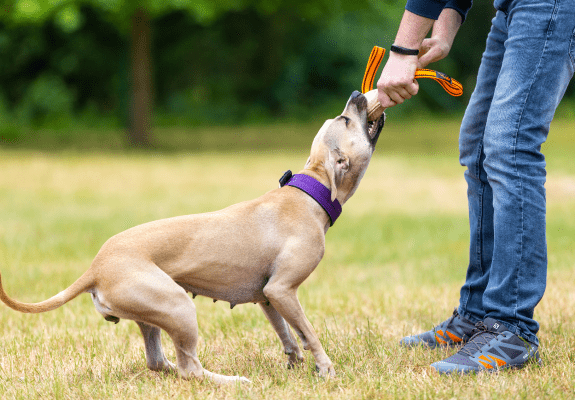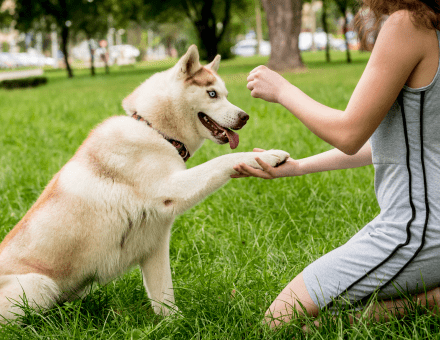Dog Behavior Modification

Behavior modification of dogs
Behavior modification entails modifying a dog or puppy’s behavior for the purpose of increasing or decreasing the behavior of interest. For example, getting your dog or puppy to sit faster, or getting your dog to stop growling at people as they are coming into your home.
Unlike dog obedience training, which is utilized for training a dog to perform specific actions when asked, behavior modification looks to change a dog’s reaction to a situation (with people, other animals, and so on).
Examples of behavior that requires behavior modification are:
- Excessive barking
- Submissive peeing
- Separation anxiety
- Jumping on people
- Chewing on and destroying objects
- Making a mess around the home
- Any kind of dog aggression behavior including biting






Positive Reinforcement
One way to modify behavior is by using positive reinforcement. This method tends to work quickly and is my preferred method to modify a behavior. Positive reinforcement involves offering a reward for positive behaviors to encourage your dog to keep doing them.
In most cases, positive reinforcement works very well. In cases where positive reinforcement doesn’t work, I will show you how to handle those, so we successfully gain the desired behavior(s).
Key benefits
Healthy communication
Open up healthy communication with your dog and develop the leader-follower relationship.
A well-balanced and happy dog
Get your dog back to a balanced state to help your dog relax
Changing the focal point
You can’t change the environment. Instead, modify an undesired behavior by changing the dog’s focal point.
Dog walks
Dog walks become safer and more enjoyable
Dog learns to trust its owner’s decisions
Your dog will follow you and not try to do its own thing
Dog is a loved member of the family
The dog is integrated into your family, ensuring your dog is a loved member of the family.
Lifetime dog training guarantee
Training you how to train your dog is a crucial element of your dog’s training. Even the strongest of “owners-trainers” need support from time to time. Knowing that you have me to support you over the life of your dog is a reassuring asset.
Aggressive Dog Training
Aggressive dog training falls into behavior modification. Aggressive dog behavior includes:
- Aggression toward people
- Aggression toward kids or young children
- Aggression toward other dogs or animals such as cats
- Combination of both aggression toward people and other dogs
Many of the dogs that Gary works to correct behaviors for are aggressive dogs.
Learn more about dog aggression and how to better handle it.


Intervening with Aggressive Puppies
Just as important for a puppy’s development and socialization, is working with your puppy to eliminate its fears and phobias. As young puppies are developing, they go through a lot of stressors as well as a fear period between 14 to 16 weeks of age.
If a puppy’s fears aren’t dealt with, it can become aggressive. Gary works with puppy owners to address this through his effective and custom-tailored puppy development training programs.
Contact With Gary
If you are dealing with an aggressive dog or a dog with a history of biting, please contact Gary. Rest assured, he can help

Related Articles:
Establish engagement with your dog
Hear from our clients

 Gary is a great trainer who has really helped me get "unstuck" in trying to train my two young rescues. I have had many dogs that I have successfully trained in the past, but couldn't get beyond the 80% mark with this young, bonded pair. His insights and behavioral approach not only make sense, but it works! Both dogs are much more relaxed and definitely obedient 🙂 The dogs and I all enjoyed the training and will continue to apply everything we learned!
Gary is a great trainer who has really helped me get "unstuck" in trying to train my two young rescues. I have had many dogs that I have successfully trained in the past, but couldn't get beyond the 80% mark with this young, bonded pair. His insights and behavioral approach not only make sense, but it works! Both dogs are much more relaxed and definitely obedient 🙂 The dogs and I all enjoyed the training and will continue to apply everything we learned! 


 There's no shortage of five-star reviews for Gary Maria, and I'm happy to add mine to the list. Working with Gary is undoubtedly an investment, but it's worth making. He equipped "us, the humans" with the knowledge and techniques to understand our new rescue, helping us build trust and communication. We started with a dog who ignored commands, chased our three cats, and did whatever he wanted. After just six weeks, thanks to Gary's guidance, he's become more confident and trusting in us. Watching his progress--and our own--has been incredibly rewarding. We highly recommend Gary!
There's no shortage of five-star reviews for Gary Maria, and I'm happy to add mine to the list. Working with Gary is undoubtedly an investment, but it's worth making. He equipped "us, the humans" with the knowledge and techniques to understand our new rescue, helping us build trust and communication. We started with a dog who ignored commands, chased our three cats, and did whatever he wanted. After just six weeks, thanks to Gary's guidance, he's become more confident and trusting in us. Watching his progress--and our own--has been incredibly rewarding. We highly recommend Gary! 


 Gary Maria, is an outstanding communicator and trainer. Our dog has fear aggression issues. Gary was able to give us the ability to recognize the signs and the tools to work with him to make him feel more comfortable. His approach has allowed our dog to be much calmer and feel protected. I would highly recommend Gary for your training needs.
Gary Maria, is an outstanding communicator and trainer. Our dog has fear aggression issues. Gary was able to give us the ability to recognize the signs and the tools to work with him to make him feel more comfortable. His approach has allowed our dog to be much calmer and feel protected. I would highly recommend Gary for your training needs. 

Ensuring your dog is a loved member of your family
Gary Maria is one of the most sought after and experienced dog behavior specialists in the Bay Area and is recognized as an expert in the field.
Since 1977, Gary has improved the behavior of thousands of dogs using his combination of proven techniques.





